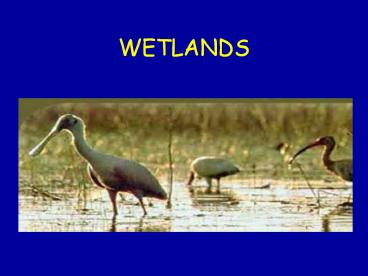WETLANDS - PowerPoint PPT Presentation
Title:
WETLANDS
Description:
WETLANDS 2 Categories of Wetlands Coastal Wetlands occur near the ocean and are closely linked to estuaries Inland Wetlands occur everywhere from plains to mountain ... – PowerPoint PPT presentation
Number of Views:985
Avg rating:3.0/5.0
Title: WETLANDS
1
WETLANDS
2
2 Categories of Wetlands
- Coastal Wetlands occur near the ocean and are
closely linked to estuaries - Inland Wetlands occur everywhere from plains to
mountain tops
3
Defined
- areas of habitat that have waterlogged soils and
are at least periodically covered with water - the plants that grow in the area are also
distinctive
4
Why isnt it always covered with water?
- Because the land does not always have standing
water in all places - low lying areas or basins gather rain and runoff
- ground water and the water table lie at the
surface - rivers sometimes overflow their banks
- tidal areas vary
5
Functions of Wetlands
- flood control- acts as shallow bowls which slow
water velocity, collects and spreads water
6
- silt traps - silt will settle out once it reaches
slow flowing wetlands areas and then the plants
will absorb or trap the silt
Trapping silt in wetlands prevents it from
entering the streams and causing habitat damage
7
- Drinking water is affected by wetland health
- refill underground aquifers
- wetlands act as
- filters that cleans
- our water before it
- enters the aquifer
8
- storm breakers - buffers winds and waves along
coastlines also stops lots of sediments from
entering bays and lagoons
Plants stabilize shorelines and protect inland
areas
9
- habitat - provides food, shelter, water, space
for all types of wildlife - stop over resting places for migratory wildlife
- habitat for many endangered species
10
- absorbs pollutants - wetland plants can absorb
and store pollutants like heavy metals,
pesticides.. - Natural filters
11
- nurseries - perfect place to raise young as the
vegetation provides shelter from predators and
lots of food for quick growth - prime breeding habitat for shrimp, crabs,
waterfowl
12
- Regulates climate - wetland plants and animals
are part of the global water and nitrogen cycles.
Wetland plants store carbon instead of releasing
it into the atmosphere--reducing gases which
contribute to global warming
13
- Fire control - wetter areas tend to burn less
- since wetlands often follow corridors along
streams and lakes, they make natural fire breaks
14
Reasons for Wetland Destruction
- People often
- viewed wetlands
- as places to drain
- and develop
- --as a nonuseful piece of land that could be made
useful
15
- agriculture
- perfect soil for water loving crops
- low-cost irrigation
16
It is a natural source of water for grazing
animals
Streams could be channeled for irrigation and
flood control
17
- Commercial and
- industrial uses
18
- Mining - removing the vegetation removes the
ability of the land to absorb pollutants - wetlands would prevent mine
- waste from damaging streams
19
- recreational
20
- housing development - everyone wants a place to
live, so houses - could be built
- andyou have to get
- to work, shopping...
21
- Introduction of non-native species displace
native plants and grow uncontrollably by natural
means
Brazilian Pepper destroys habitat for wading birds
Purple Loosestrife quickly crowds out native
species and replaces food plants and needed
habitat
22
Types of Wetlands
- salt marshes (pocosins and others) often have
tidal influences but the salinity is lower than
in coastal marshes
23
- mangrove swamps
24
- freshwater marshes
25
Wetlands do not always look like what most people
think of as wetlands--the difference is in the
soil and plants
Vernal Ponds are dry most of the year, yet they
are critical to amphibians for breeding habitat
26
- fen is a type of freshwater marsh, with peat moss
dominating - has more oxygen and less acidity than the bogs so
it will support more life - found in northern regions where its cooler
27
- bogs and muskegs are found in colder regions
- dominated by sphagnum moss
- lower oxygen
- very acidic
28
- Everglades -often called the river of grass are
found in Florida
29
ANY QUESTIONS?































